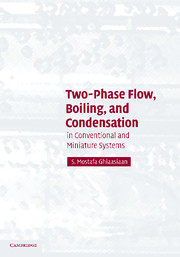Book contents
- Frontmatter
- Contents
- Preface
- Frequently Used Notation
- TWO-PHASE FLOW, BOILING AND CONDENSATION IN CONVENTIONAL AND MINIATURE SYSTEMS
- PART ONE TWO-PHASE FLOW
- PART TWO BOILING AND CONDENSATION
- 11 Pool Boiling
- 12 Flow Boiling
- 13 Critical Heat Flux and Post-CHF Heat Transfer in Flow Boiling
- 14 Flow Boiling and CHF in Small Passages
- 15 Fundamentals of Condensation
- 16 Internal-Flow Condensation and Condensation on Liquid Jets and Droplets
- 17 Choking in Two-Phase Flow
- APPENDIX A Thermodynamic Properties of Saturated Water and Steam
- APPENDIX B Transport Properties of Saturated Water and Steam
- APPENDIX C Thermodynamic Properties of Saturated Liquid and Vapor for Selected Refrigerants
- APPENDIX D Properties of Selected Ideal Gases at 1 Atmosphere
- APPENDIX E Binary Diffusion Coefficients of Selected Gases in Air at 1 Atmosphere
- APPENDIX F Henry's Constant of Dilute Aqueous Solutions of Selected Substances at Moderate Pressures
- APPENDIX G Diffusion Coefficients of Selected Substances in Water at Infinite Dilution at 25°C
- APPENDIX H Lennard–Jones Potential Model Constants for Selected Molecules
- APPENDIX I Collision Integrates for the Lennard–Jones Potential Model
- APPENDIX J Physical Constants
- APPENDIX K Unit Conversions
- References
- Index
17 - Choking in Two-Phase Flow
- Frontmatter
- Contents
- Preface
- Frequently Used Notation
- TWO-PHASE FLOW, BOILING AND CONDENSATION IN CONVENTIONAL AND MINIATURE SYSTEMS
- PART ONE TWO-PHASE FLOW
- PART TWO BOILING AND CONDENSATION
- 11 Pool Boiling
- 12 Flow Boiling
- 13 Critical Heat Flux and Post-CHF Heat Transfer in Flow Boiling
- 14 Flow Boiling and CHF in Small Passages
- 15 Fundamentals of Condensation
- 16 Internal-Flow Condensation and Condensation on Liquid Jets and Droplets
- 17 Choking in Two-Phase Flow
- APPENDIX A Thermodynamic Properties of Saturated Water and Steam
- APPENDIX B Transport Properties of Saturated Water and Steam
- APPENDIX C Thermodynamic Properties of Saturated Liquid and Vapor for Selected Refrigerants
- APPENDIX D Properties of Selected Ideal Gases at 1 Atmosphere
- APPENDIX E Binary Diffusion Coefficients of Selected Gases in Air at 1 Atmosphere
- APPENDIX F Henry's Constant of Dilute Aqueous Solutions of Selected Substances at Moderate Pressures
- APPENDIX G Diffusion Coefficients of Selected Substances in Water at Infinite Dilution at 25°C
- APPENDIX H Lennard–Jones Potential Model Constants for Selected Molecules
- APPENDIX I Collision Integrates for the Lennard–Jones Potential Model
- APPENDIX J Physical Constants
- APPENDIX K Unit Conversions
- References
- Index
Summary
Physics of Choking
Choking can happen when a fluid is discharged through a passage from a pressurized chamber into a chamber that is at a significantly lower pressure. When a flow passage is choked, it supports the maximum possible fluid discharge rate for the given system conditions.
Choking can be better understood by the simple experiment shown in Fig. 17.1, where a chamber containing a fluid at an elevated pressure P0 is connected to another chamber that is at a lower pressure Pout by a flow passage. Suppose that the upstream conditions are maintained unchanged in the experiment, while the pressure in the downstream chamber, Pout, is gradually reduced, and the mass flow rate is continuously measured. It will be observed that the mass flux increases as Pout is reduced, until Pout reaches a critical value Pch. Further reduction of Pout will have no impact on mass flux or anything else associated with the channel interior.
The physical explanation of critical flow is as follows. A flow is critical (choked) when disturbances (or hydrodynamic signals) initiated downstream of some critical cross section cannot propagate upstream of the critical cross section. In single-phase flow, infinitesimally small disturbances (hydrodynamic signals) travel with the speed of sound. In a straight channel often the critical cross section occurs at the exit. In nozzles and other converging–diverging channels, the throat acts as the critical cross section.
- Type
- Chapter
- Information
- Two-Phase Flow, Boiling, and CondensationIn Conventional and Miniature Systems, pp. 499 - 528Publisher: Cambridge University PressPrint publication year: 2007



